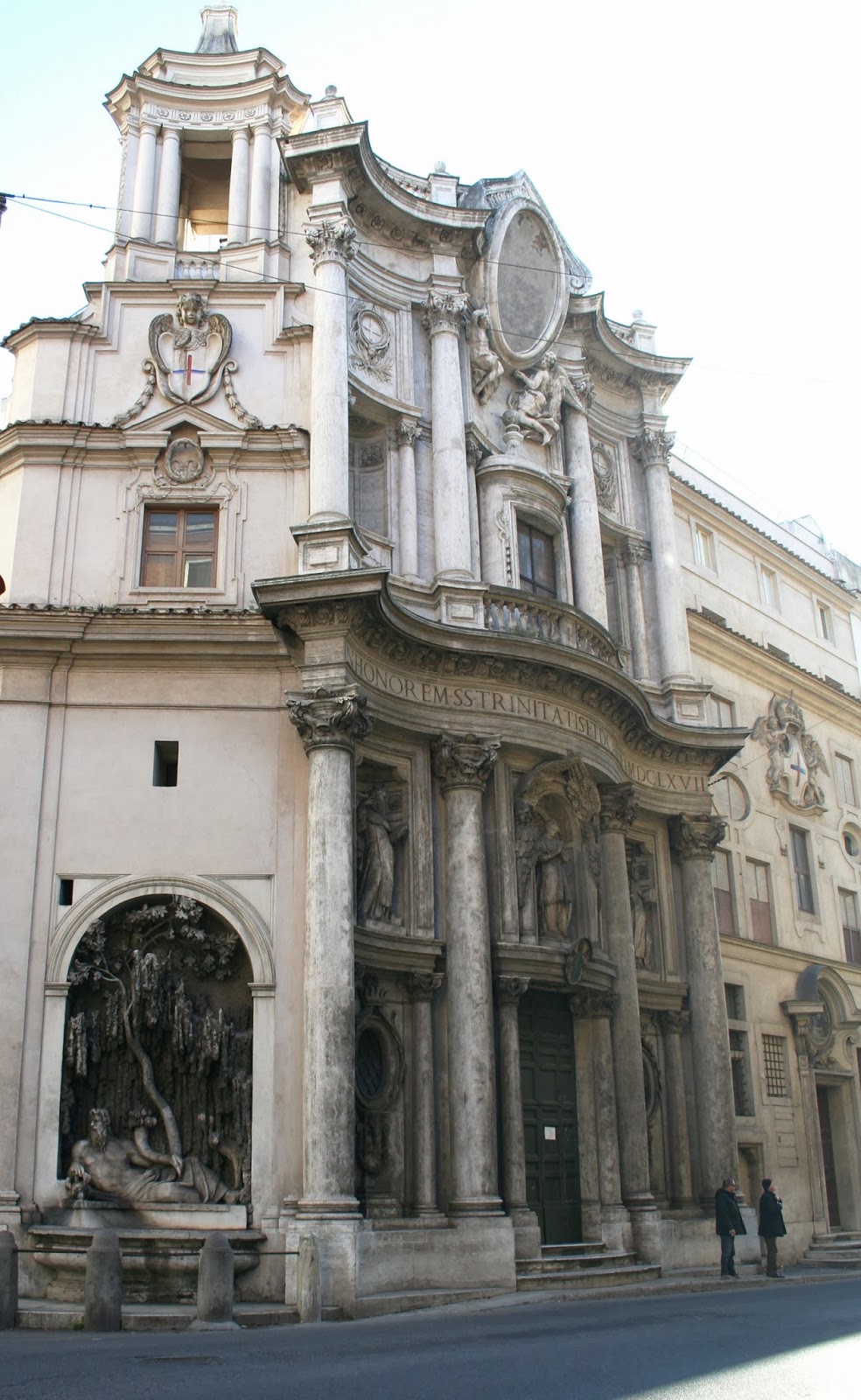People devote their entire careers to analyzing the architecture of Rome. In a thousand words I won’t be able to begin to begin to scratch the surface. I will be content with sharing a few thoughts on the things that moved me. The common thread (which is tenuous in places) is a connection with either Bernini or Borromini. Earlier this summer I read the excellent book The Genius in the Design, which chronicled the bitter rivalry between Borromini and Bernini. While Bernini was indeed a prodigious talent, I found myself drawn more to Borromini. I was anxious to see if would still feel that way after experiencing their built work. As an aside, I hope it’s not a bad sign that in the past six months I’ve been fixated on two tortured souls. I’m absolutely fascinated with both Louis Sullivan, who died a bitter man, penniless, alone and with no clients, and Borromini who after alienating his friends and clients, went loony and ran himself through with a sword.
San Carlo Alle Quattro Fontane
This is one of Borromini’s masterworks and the one building in Rome that I was most looking forward to seeing. It did not disappoint. I was, in fact, moved to tears. As advertised, the building is tiny, but no less impressive for it. This was not the grandest space we saw, nor was it the most modest, but God was in that place. It is rare that the genuine physical article surpasses expectations bred of imagination and anticipation, but oh the joy of experiencing those moments.
Sant’Andrea Al Quirinale
This was the Bernini building that I was most looking forward to. Unfortunately for me, the interior was closed for restoration. I can’t blame Bernini, but this building held his best chance to win me over.
S. Ivo Della Sapienza
This Borromini building had a profound effect on me. The church is only open once a week, for Mass on Sundays. The four-day wait to see the interior added an element of delayed gratification. The exterior, however, was more accessible. S. Ivo was a couple of blocks or away from our hotel, and we had a great view of the unique spiral lantern from our balcony. The approach to the church is open, and starts with a normal door in a rather normal building façade opening into a two-story, colonnaded cloister (designed by della Porta). That Sunday morning, I woke up bright and early, put on my Sunday best and walked by myself to the church. The weather was perfect- sunny, crisp and clear. Having arrived early, I was gifted a few moments to sit and reflect. When the doors were opened, I had the place to myself. I passed through della Porta’s cloister and into Borromini’s sacred space. Sacred is the best description I can offer. It is one of those places that makes you feel. It is a place of adjectives- awe, wonder, quiet, power, love. Out of respect for the parishioners who would soon arrive for worship, I did not tarry. But I will never forget the few minutes I had alone in Sant’Ivo.
Il Gesu
As the first full-blown Baroque church, I pretty much had to go see Il Gesu. Was I particularly excited about the work of Vignola and della Porta? Eh, not really. It was, however, a very pleasant surprise. It is exactly what you think a Baroque church would be- effusive, ebullient, and over-the-top. Normally, that stuff doesn’t move me, but there was no denying the force of this work. The ceiling fresco is absolutely stunning and is one of the most memorable surprises of the trip. The link to Bernini/Borromini is tenuous at best – Bernini sculpted a bust in the presbytery.
St. Peter’s Basilica
With respect to the Rose Bowl, this is the Granddaddy of them all. This is the biggest and grandest church in the world. It is undeniably impressive, and adjectives don’t do it justice. It’s impossible not to be moved this remarkable edifice. As impressive as the structure is, I am enthralled by the history of its construction. Over the course of 160 years, the plan was conceived by Bramante, fiddled with by lesser minds, rectified by Michelangelo, carried on by della Porta, (unfortunately) extended by Maderno, and tricked out by Bernini (with the help of one Francesco Borromini). This is a truly fascinating story about the relationships between architects, other architects, their clients (Popes), and how projects evolve over time. If you don’t know it, treat yourself.
 |
| Hmm, would we rather see Maderno's facade or Michelangelo's dome? |
 |
| Don't let the picture fool you. At 98' The baldacchino is as tall our Aquarium's Ocean Journey. |
 |
| How big is it? If you stacked the Suntrust Building on top of the Volunteer Building, they would both fit under St. Peter's dome. (With 2 feet to spare) |
This building is 1,888 years old. One thousand eight hundred and eighty eight years old. It was originally a tribute to seven Roman gods, but was later converted to a Christian church. This conversion was fortunate for us, since it meant that the interior was never looted and remains much the same as it was 1,888 years ago (that’s almost two millennia to you and me). However, bronze from the portico was stripped, melted and used for the baldachin at St. Peter’s (yes, the same baldachin on which Bernini and Borromini collaborated). The Pantheon is truly remarkable. As it was on the doorstep of the hotel, it served as a constant backdrop for the trip. I enjoyed this building immensely.
 |
| That would be the largest un-reinforced concrete dome ever created. |
 |
| As if I wasn't going to drop some Tempietto on you. |
Have a great week. Next week, hopefully we’ll get back to issues closer to home.


















No comments:
Post a Comment